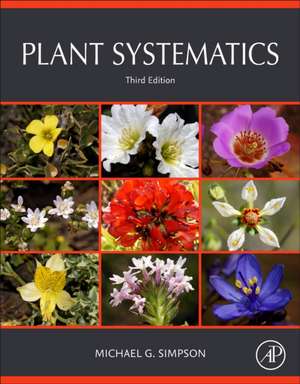Plant Systematics
Autor Michael G. Simpsonen Limba Engleză Paperback – 9 ian 2020
In this new edition, the author includes greatly expanded treatments on families of flowering plants, as well as tropical trees (all with full-color plates), and an updated explanation of maximum likelihood and Bayesian inference algorithms. Chapters on morphology and plant nomenclature have also been enhanced with new material.
- Covers research developments in plant molecular biology
- Features clear, detailed cladograms, drawings and photos
- Includes major revisions to chapters on phylogenetic systematics and plant morphology
Preț: 539.43 lei
Preț vechi: 682.82 lei
-21% Nou
Puncte Express: 809
Preț estimativ în valută:
103.24€ • 108.91$ • 86.04£
103.24€ • 108.91$ • 86.04£
Carte disponibilă
Livrare economică 12-26 decembrie
Livrare express 28 noiembrie-04 decembrie pentru 87.01 lei
Preluare comenzi: 021 569.72.76
Specificații
ISBN-13: 9780128126288
ISBN-10: 0128126280
Pagini: 774
Dimensiuni: 216 x 276 x 41 mm
Greutate: 2.1 kg
Ediția:3
Editura: ELSEVIER SCIENCE
ISBN-10: 0128126280
Pagini: 774
Dimensiuni: 216 x 276 x 41 mm
Greutate: 2.1 kg
Ediția:3
Editura: ELSEVIER SCIENCE
Public țintă
Graduate and undergraduate students in botany, plant taxonomy, plant systematics, plant pathology, plant anatomy, and ecology; scientists and researchers in any of the plant sciencesCuprins
UNIT I SYSTEMATICS 1. Plant Systematics: An Overview 2. Phylogenetic Systematics
UNIT II EVOLUTION AND DIVERSITY OF PLANTS 3. Evolution and Diversity of Green and Land Plants 4. Evolution and Diversity of Vascular Plants 5. Evolution and Diversity of Woody and Seed Plants 6. Evolution of Flowering Plants 7. Diversity and Classification of Flowering Plants: Amborellales, Nymphaeales, Austrobaileyales, Magnoliids, Ceratophyllales, and Monocots 8. Diversity and Classification of Flowering Plants: Eudicots
UNIT III SYSTEMATIC EVIDENCE AND DESCRIPTIVE TERMINOLOGY 9. Plant Morphology Chapter 10. Plant Anatomy and Physiology 11. Plant Embryology 12. Palynology 13. Plant Reproductive Biology 14. Plant Molecular Systematics
UNIT IV RESOURCES IN PLANT SYSTEMATICS 15. Plant Identification 16. Plant Nomenclature 17. Plant Collecting and Documentation 18. Herbaria and Data Information Systems
UNIT V SPECIES CONCEPTS AND CONSERVATION BIOLOGY 19. Species and Conservation in Systematics
Appendix 1. Plant Description 2. Botanical Illustrations 3. Scientific Journals in Plant Systematics 4. Statistics and Morphometrics in Plant Systematics
UNIT II EVOLUTION AND DIVERSITY OF PLANTS 3. Evolution and Diversity of Green and Land Plants 4. Evolution and Diversity of Vascular Plants 5. Evolution and Diversity of Woody and Seed Plants 6. Evolution of Flowering Plants 7. Diversity and Classification of Flowering Plants: Amborellales, Nymphaeales, Austrobaileyales, Magnoliids, Ceratophyllales, and Monocots 8. Diversity and Classification of Flowering Plants: Eudicots
UNIT III SYSTEMATIC EVIDENCE AND DESCRIPTIVE TERMINOLOGY 9. Plant Morphology Chapter 10. Plant Anatomy and Physiology 11. Plant Embryology 12. Palynology 13. Plant Reproductive Biology 14. Plant Molecular Systematics
UNIT IV RESOURCES IN PLANT SYSTEMATICS 15. Plant Identification 16. Plant Nomenclature 17. Plant Collecting and Documentation 18. Herbaria and Data Information Systems
UNIT V SPECIES CONCEPTS AND CONSERVATION BIOLOGY 19. Species and Conservation in Systematics
Appendix 1. Plant Description 2. Botanical Illustrations 3. Scientific Journals in Plant Systematics 4. Statistics and Morphometrics in Plant Systematics
Notă biografică
Dr. Michael G. Simpson has been a professor of Biology at San Diego State University since 1986. His area of expertise is plant systematics, dealing with the description, identification, naming and classification of plants with the overriding goal of inferring the pattern of evolutionary history (phylogeny). Dr. Simpson has taught courses in Principles of Organismal Biology, Plant Systematics, Taxonomy of California Plants, Economic Botany, Genetics and Evolution, and Seminar in Systematics and Evolution. Additionally, he serves as the Curator of the SDSU Herbarium where he oversees the maintenance, organization, and use of the collection and facilitates additions to the herbarium. Currently, his field work in Chile and Argentina is supported in part by the National Geographic Society.
In addition to publishing numerous articles in technical journals, Dr. Simpson has authored of the widely used textbook Plant Systematics (Elsevier-Academic Press, 2006; 2nd ed. 2010.)
